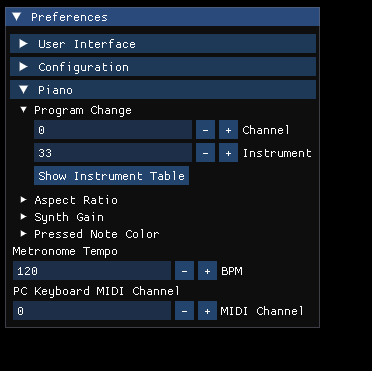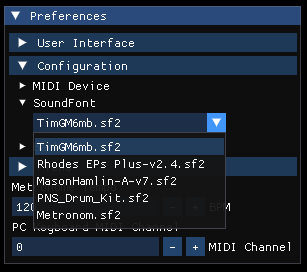Changing Instruments
Program Change
Chordcat comes with 128 default instruments (a.k.a programs) as prescribed in the General MIDI spec.
You can also play all 16 MIDI channels simultaneously with 16 MIDI devices. You can bind any instrument to any channel.
To bind an instrument to a channel, say you want to bind the electric bass to the default channel, channel 0.
You can go to Preferences -> Piano -> Program Change and bind
instrument 33 to channel 0 like so:

The instrument numbers are from the General MIDI spec. You can view
all the instruments and their codes by clicking on Show Instrument
Table in the app.
Here is the instrument table for your reference:
Instrument Table
| Piano | Chromatic Percussion | Organ |
|---|---|---|
| 0 Acoustic Grand Piano | 8 Celesta | 16 Drawbar Organ |
| 1 Bright Acoustic Piano | 9 Glockenspiel | 17 Percussive Organ |
| 2 Electric Grand Piano | 10 Music Box | 18 Rock Organ |
| 3 Honky-tonk Piano | 11 Vibraphone | 19 Church Organ |
| 4 Electric Piano 1 | 12 Marimba | 20 Reed Organ |
| 5 Electric Piano 2 | 13 Xylophone | 21 Accordion |
| 6 Harpsichord | 14 Tubular Bells | 22 Harmonica |
| 7 Clavinet | 15 Dulcimer | 23 Bandoneon |
| Guitar | Bass | Strings |
| 24 Acoustic Guitar (nylon) | 32 Acoustic Bass | 40 Violin |
| 25 Acoustic Guitar (steel) | 33 Electric Bass (finger) | 41 Viola |
| 26 Electric Guitar (jazz) | 34 Electric Bass (picked) | 42 Cello |
| 27 Electric Guitar (clean) | 35 Electric Bass (fretless) | 43 Contrabass |
| 28 Electric Guitar (muted) | 36 Slap Bass 1 | 44 Tremolo Strings |
| 29 Electric Guitar (overdrive) | 37 Slap Bass 2 | 45 Pizzicato Strings |
| 30 Electric Guitar (distortion) | 38 Synth Bass 1 | 46 Orchestral Harp |
| 31 Electric Guitar (harmonics) | 39 Synth Bass 2 | 47 Timpani |
| Ensemble | Brass | Reed |
| 48 String Ensemble 1 | 56 Trumpet | 64 Soprano Sax |
| 49 String Ensemble 2 | 57 Trombone | 65 Alto Sax |
| 50 Synth Strings 1 | 58 Tuba | 66 Tenor Sax |
| 51 Synth Strings 2 | 59 Muted Trumpet | 67 Baritone Sax |
| 52 Choir Aahs | 60 French Horn | 68 Oboe |
| 53 Voice Oohs | 61 Brass Section | 69 English Horn |
| 54 Synth Voice | 62 Synth Brass 1 | 70 Bassoon |
| 55 Orchestra Hit | 63 Synth Brass 2 | 71 Clarinet |
| Pipe | Synth Lead | Synth Pad |
| 72 Piccolo | 80 Lead 1 (square) | 88 Pad 1 (new age) |
| 73 Flute | 81 Lead 2 (sawtooth) | 89 Pad 2 (warm) |
| 74 Recorder | 82 Lead 3 (calliope) | 90 Pad 3 (polysynth) |
| 75 Pan Flute | 83 Lead 4 (chiff) | 91 Pad 4 (choir) |
| 76 Blown Bottle | 84 Lead 5 (charang) | 92 Pad 5 (bowed glass) |
| 77 Shakuhachi | 85 Lead 6 (voice) | 93 Pad 6 (metallic) |
| 78 Whistle | 86 Lead 7 (fifths) | 94 Pad 7 (halo) |
| 79 Ocarina | 87 Lead 8 (bass and lead) | 95 Pad 8 (sweep) |
| Synth Effects | Ethnic | Percussive |
| 96 FX 1 (rain) | 104 Sitar | 112 Tinkle Bell |
| 97 FX 2 (soundtrack) | 105 Banjo | 113 Cowbell |
| 98 FX 3 (crystal) | 106 Shamisen | 114 Steel Drums |
| 99 FX 4 (atmosphere) | 107 Koto | 115 Woodblock |
| 100 FX 5 (brightness) | 108 Kalimba | 116 Taiko Drum |
| 101 FX 6 (goblins) | 109 Bag pipe | 117 Melodic Tom |
| 102 FX 7 (echoes) | 110 Fiddle | 118 Synth Drum |
| 103 FX 8 (sci-fi) | 111 Shanai | 119 Reverse Cymbal |
| Sound Effects | ||
| 120 Guitar Fret Noise | ||
| 121 Breath Noise | ||
| 122 Seashore | ||
| 123 Bird Tweet | ||
| 124 Telephone Ring | ||
| 125 Helicopter | ||
| 126 Applause | ||
| 127 Gunshot |
Loading Soundfonts
If you want to use a different soundfont to the default one, you can
download any .sf2 soundfont (extension must be lowercase) and paste
it in the soundfonts folder.
The soundfont folder is different depending on your OS.
- Linux and MacOS :
$XDG_DATA_DIR/chordcat/soundfontswhich is~/.local/share/chordcat/soundfonts/on most systems. - Linux Flatpak:
~/.var/app/dev.ters.Chordcat/data/chordcat/soundfonts/ - Michaelsoft Binbows :
%AppData%\chordcat\soundfonts\
Once you have pasted your soundfonts, restart chordcat. You can then
select your soundfont in Preferences -> Configuration ->
Soundfont.
When a new soundfont is loaded, the corresponding instrument out of the 128 default instruments, is replaced with the new soundfont. The remaining instruments are unchanged.
